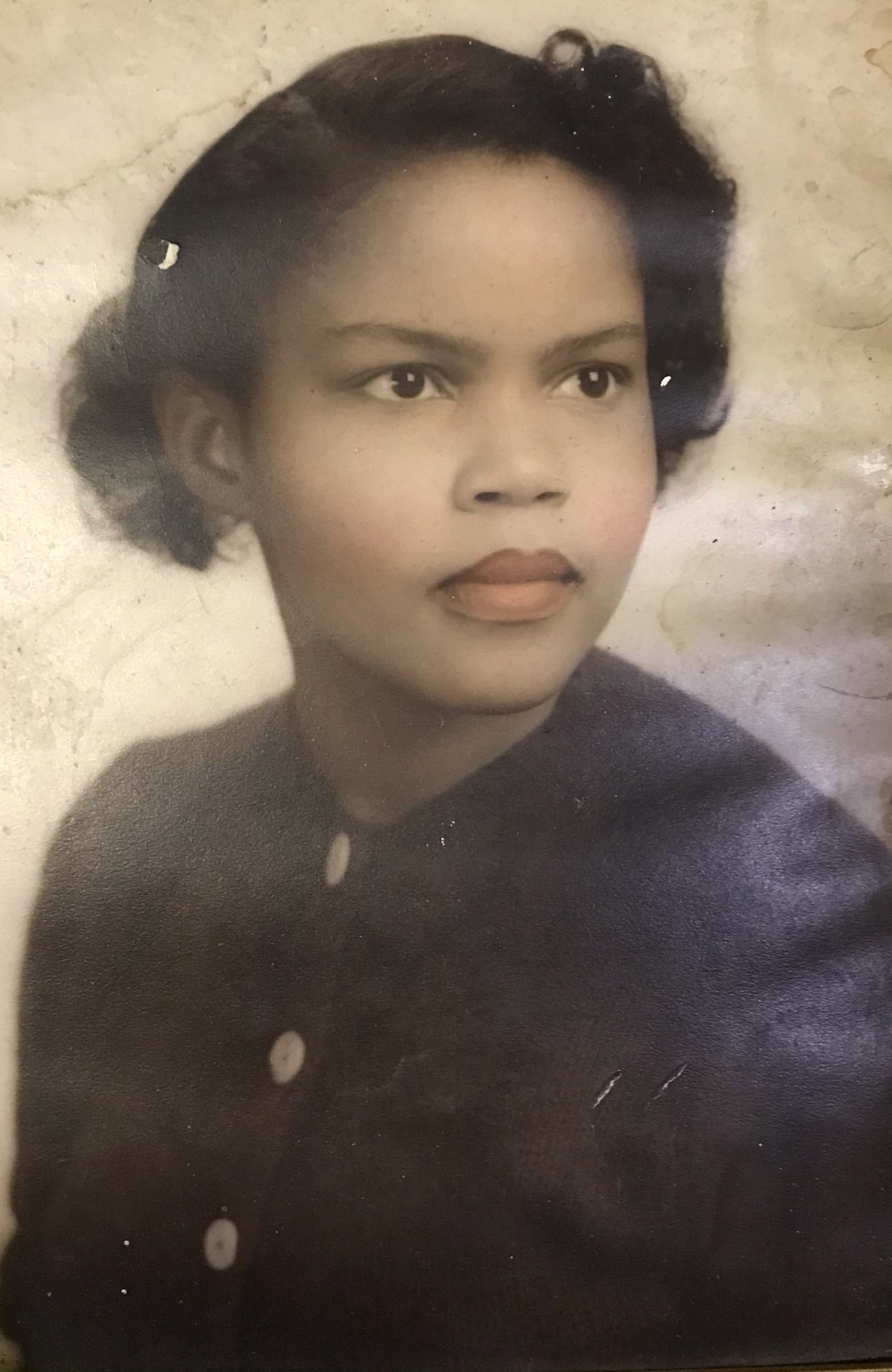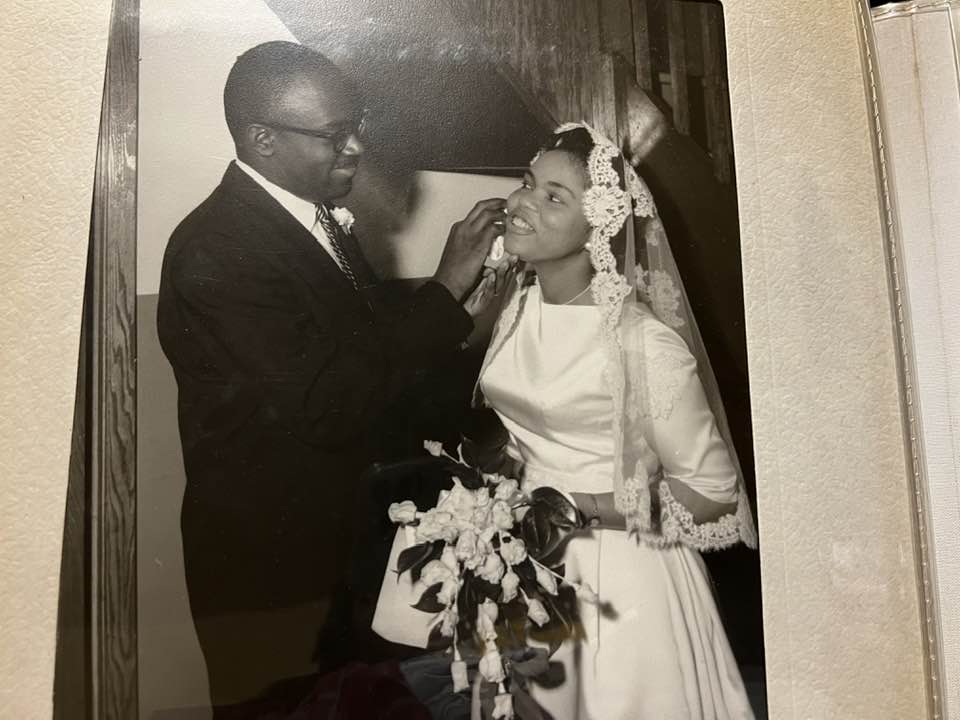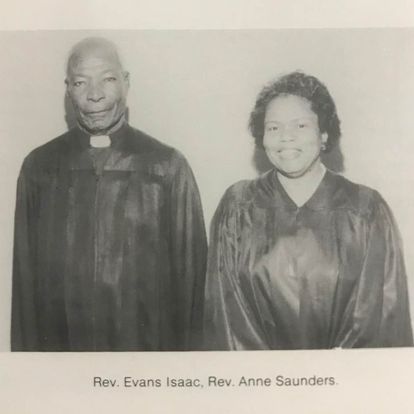
The Reverend Anne Saunders almost died when she was a child. Scarlet fever ran rampant, afflicting children everywhere, regardless of the color of their skin or how much money their families had. In the late 1930s, most children stayed home to heal, but Anne Saunders was so sick that her father wanted to take her to the hospital. He was told that if he took her to the hospital, she wouldn’t be alive when she got there.
Her father and his friend, the Pastor Steward Green, went outside and prayed. And a miracle occurred; she was healed. While she didn’t die, her body had been ravaged by scarlet fever. A long time would pass before complete healing would come. Now ninety years old, Reverend Saunders rarely got sick again. She was sick with the flu once, and had colds in the winter, but other than that, she really hasn’t been sick.
While she was healing from scarlet fever, her father wanted her to eat. Back then, people believed eating a lot meant being healthy. Her mother made pies, apple, cherry, peach. The fruit came from trees in the family’s garden in Mt. Vernon, New York, a small city bordering the Bronx.
The garden and her home sat on a large lot. “My father was always going to build another house there,” Reverend Saunders said. The garden had several types of apple trees, cherry trees, and peach trees. The family grew strawberries, collards, beets, all kinds of vegetables, and flowers galore, chrysanthemums, lilies, dahlias, snowdrops. The family also had chickens and at one time they had a goat and a big snapping turtle. Anne spent most of her life tending this garden.
Today, Reverend Saunders is no longer living in the house with the garden, but she lives nearby in a smaller house, where her husband grew up. For most of her life she has been tending another kind of garden, a place to find God.
At church, she sang in the choir and played the piano. In elementary school, her teachers wrote a lot of plays. “And for some reason, they always used to make me the announcer,” she said. She started taking piano lessons when she was seven and performed during her school graduations. Singing in the choir, the psalms, the songs, the rhythm and the meaning, stayed with her all of her life.
The Reverend Anne Saunders was born February 15, 1934, in Buffalo, New York. She grew up in Mount Vernon. She moved there as a small child around 1937. She remembers going back and forth by train to Buffalo, where her grandmother and aunts and uncles lived. Her mother came from Downingtown, Pennsylvania, a borough in Chester County, Pennsylvania. She remembers a good life and describes how youngsters all played together, and the neighbors were almost like family. “That's the way it was when I first came to Mount Vernon,” she said.
As an only child, she remembers being lonely, but she had her garden and her friends in the neighborhood. Her bout with scarlet fever had kept her out of school, but she soon caught up. She remembers being in Kindergarten One, and wasn’t quite ready to go to Kindergarten Two, but the teacher took her out of the class and taught her to read under the light of the porch. She loved to read fairy tales and wanted the fairies to come to life in her garden.
She went to public schools: Nathan Hale Elementary school, Washington Junior High, AB Davis High School. The names of all of the schools have changed now. Today’s Cecil Parker Elementary School was formerly Nathan Hale Elementary School, and the current Mount Vernon High School came into existence from the merger of the former A.B. Davis High School and Edison Tech in 1964. Always a good student, Reverend Saunders ended up going to college at the University of Buffalo Pharmacy School.
Pharmacy was her father’s idea. Her father was working on a project to get all of the black doctors together to start a medical center, and they would need a pharmacist. “I stayed there for two years,” she said, “and that was the end of that.” She recalls when she was growing up not having anything to say about what she wanted to do for a career. “Parents decided that.” She had wanted to go to Oberlin to study music, but that was changed.
Despite her long journey ahead as a teacher, a wife, a mother, and caretaker to her parents, she never lost her song. Singing stayed in her heart, and singing led to her own spiritual garden, the place to be with God.
 After two years at the University of Buffalo, she went to Hunter College in New York City and studied Home Economics. She was still living at home with her parents when she went to Hunter, and her father had approved of her new focus on education. Then she went to Teacher’s College at Columbia University for her master’s degree. Home Economics had eight areas of study: art and design, economics, music, history, textiles, child development, education and sociology. “It was fun,” she said. “I loved foods, cooking, housing, and the actual study of economics.”
After two years at the University of Buffalo, she went to Hunter College in New York City and studied Home Economics. She was still living at home with her parents when she went to Hunter, and her father had approved of her new focus on education. Then she went to Teacher’s College at Columbia University for her master’s degree. Home Economics had eight areas of study: art and design, economics, music, history, textiles, child development, education and sociology. “It was fun,” she said. “I loved foods, cooking, housing, and the actual study of economics.”
Studying at Hunter College was different from pursuing a degree in pharmacy at the University of Buffalo. The student ratio was heavily male at Buffalo and there were few women. The emphasis was on academic research, and students were left on their own to attend lectures and take their own notes. At Hunter, Reverend Saunders remembers having to be in class; they actually took attendance, and she felt it was as if she was going back to high school. So, from that standpoint, she preferred the autonomy of being a student at Buffalo. Then when she went to Teacher’s College at Columbia, she found it to be very challenging but rewarding.
Her work, during and after her college years, centered on students. The summer after she graduated from Hunter, she worked as an assistant dietitian in a camp at Croton Point Park. She loved living in the wooded area and encountered wildlife that she had never seen before in urban Mt. Vernon. She remembers having a fawn as a pet for the summer. The boys and girls lived in separate camps. She remembers working with children, ages six to sixteen and staging the popular musical “Kiss Me Kate.” Wooden benches placed among the groves of trees provided seating for the plays, and also for religious services held on Sunday.
In the summer of 1950, she worked as a playground teacher at Nathan Hale School, down the street from where she lived. Boys from all over the city came by every afternoon to play basketball. “One day this younger boy named Sylvester came over to me and said, ‘Willie Saunders, he likes you.’”
“Huh? Good!” Reverend Saunders remembers she did not really respond. She also remembers seeing Willie Saunders coming by every day. The next day Sylvester came back again and said, “Well, he likes you.” Again, she didn’t really say much.
The next day Willie Saunders came over.
“We started talking to each other. I started to like him and then, later that year, I left the playground job to go to camp.”
One of his friends came to visit her at the camp. William “Willie” Saunders was in college at the time; he was going to go to Central State University in Ohio, majoring in Physical Education. The two began dating, but he had to go back to school. He graduated from Central State University, and she graduated from Hunter College. He was in the Army Reserve, so he had to go into the service, and eventually he went to Korea. While he was in Korea, they wrote to each other. He had the rank of First Lieutenant, and he was in the Medical Corps. He was in the army for two years, eighteen months in Korea. William and Anne were married in 1965 at the Greater Centennial AME Zion Church in Mount Vernon.
 William Saunders was raised as a Roman Catholic. At one time, before he was married, a parish priest wanted William to become a priest and gave him a set of rosary beads. And then there were people at the AME Zion Church, including the pastor there, who said William was called to preach, but he never did. Instead, it was Anne Saunders who was called to preach. How she came to that revelation was by listening to the song in her heart.
William Saunders was raised as a Roman Catholic. At one time, before he was married, a parish priest wanted William to become a priest and gave him a set of rosary beads. And then there were people at the AME Zion Church, including the pastor there, who said William was called to preach, but he never did. Instead, it was Anne Saunders who was called to preach. How she came to that revelation was by listening to the song in her heart.
During the early years of their marriage, the couple became immersed in their careers. Anne was teaching at Herman Ridder Junior High School in the Bronx, and later went to Nichols Junior High in Mount Vernon. She taught Home Economics for all three grades seven, eight, nine. William Saunders went to work as a social worker in the Bronx and became the director of the after school program. He worked for the Westchester Council for the Arts and a community art gallery in Mount Vernon. He was also involved with volunteers working for literacy—ultimately becoming the State Secretary of Literacy Volunteers.
Anne worked until she took time off for maternity leave. Three daughters were born in a span of five years: Barbara, February, 1967; Michele, September,1968; and Gillian, August,1971. While Anne was in the midst of juggling work and having children, her father suffered a severe stroke. After Michele was born, Anne stayed at home to help her mother take care of her father. By the time her father died, her mother had started to develop dementia. So, she stayed at home to care for her mother. Then William became sick, and no one knew for sure what was wrong with him. He spent months in the hospital with blood clots and other complications. Through the years, he was in and out of hospitals and nursing homes. It wasn’t until years later that William was finally diagnosed with Parkinson’s Disease.
Being away from the public school system for a few years narrowed Anne’s options for a teaching job. She was also older now, in her fifties. At first, she went back to work in the Mount Vernon school system, at Davis Middle School, where she taught Home Economics. She took a position with the Hallen School, a school for the developmentally disabled. There, she taught all grades. Many of the students were autistic or had disabilities that prevented them from learning at their age and grade level. She also worked at a private facility where students were inflicting self-harm, banging their heads against the wall, beating themselves up. Some students had multiple personality disorders. Some of the parents of her students had also been emotionally traumatized. They recognized their children had problems and wanted to help them but were unable to do so.
Reverend Anne Saunders had a gift for listening to what was in her heart. In times of trouble, she was never filled with despair. Her strong faith in God, in the Trinity, in Jesus, the Father and the Holy Spirit, sustained her. Soon she would inspire this strong faith in others, too.
She grew up in the church, but when she came into her teenage years, she wanted to walk away. “My father was very religious, very smart, but did not have a college education,” she said. She told her father she could be good without having to go to church. She thought the church deacons were old fogies. One Sunday, she told him she wasn’t going to church. He said, “Yes, you are.” He could be stubborn but so was she. The last time she said, “I am just not going to church,” she threw a ruckus and got her way, but she never stopped hearing the hymns playing in her head.
Years later when her husband first got sick, she remembers every time she came home from the hospital, she heard a song in her head, a hymn. And then the next time she went to church, the choir happened to be singing that same hymn.
During the tough years when she was needing to work and looking for a job, she had to go to unemployment workshops. One day she went to one of those classes and just started preaching to them. The words just flowed from her mouth, as if they had been there all along. The people needed to hear her words, and they listened. That’s when she felt a calling. She started to think about preaching.

“One Sunday, the president of our seminary came to church, and I went up to him and told him I wanted to preach.” He offered her a scholarship to the seminary and told her to go. He also told her to tell the pastor that she wanted to preach. So, she told the pastor, “I think I was called to preach,” and he said, “I know you are.” While she didn't go to the Seminary, she had to go through the whole process and was ordained September,1983 by the AME (African Methodist Episcopal) Zion Church.
Today at ninety, Reverend Saunders is no longer an active minister with the AME Zion Church, but until the pandemic, she made house calls, and these days, she helps heal people, and prays with them, one-on-one via a phone call. She also had her own cross to bear. After she took care of William for many years, he died on March 12, 2020.
Faith is a constant star. Reverend Saunders’ faith is based on the Bible. “People might like the sermon better, but the communion is sacred, and it is more important. It is the Lord’s supper. The Lord is giving you his body and blood.”
Working for many years in close contact with a wide range of people has given Reverend Anne Saunders a rare understanding of both humanity and God. God created humanity out of love. God is love. “That is what he is, love is his whole substance.” And of course, Satan was also created. The first thing Satan did was attack humanity and try to separate people from God. Any horrible circumstance from war and pestilence to racism and corruption is the handiwork of Satan.
“Pray,” she instructs us. “Jesus is here. He's with us. We're not alone. Oh, he's everywhere. Yeah. God is everywhere. And he can manifest himself to you.”
“I was called,” she said. “There is nothing I can really say to describe being called. It's hard to explain spiritual things in a worldly way. I just felt that God was calling me. And I had a dream. I don't remember the whole dream. I remember the deaconesses from the church took me up into the choir loft in the dream. That was part of it. I had a dream about being in the pulpit and I would walk down the street, and I would be making up sermons in my head. The words just came to me.”
##








